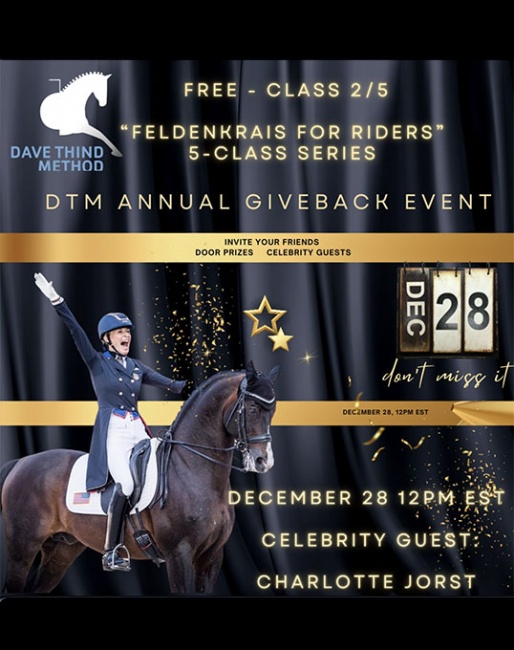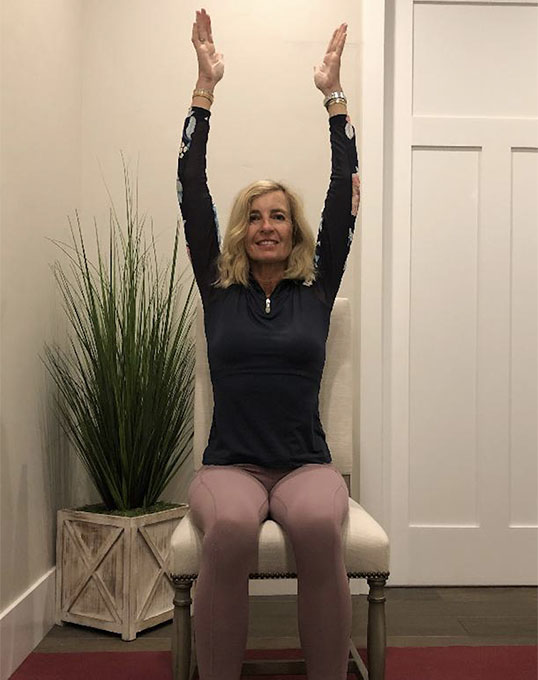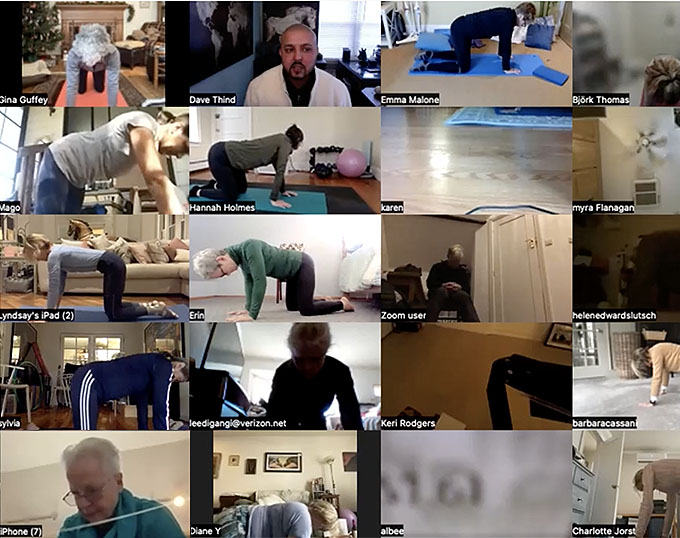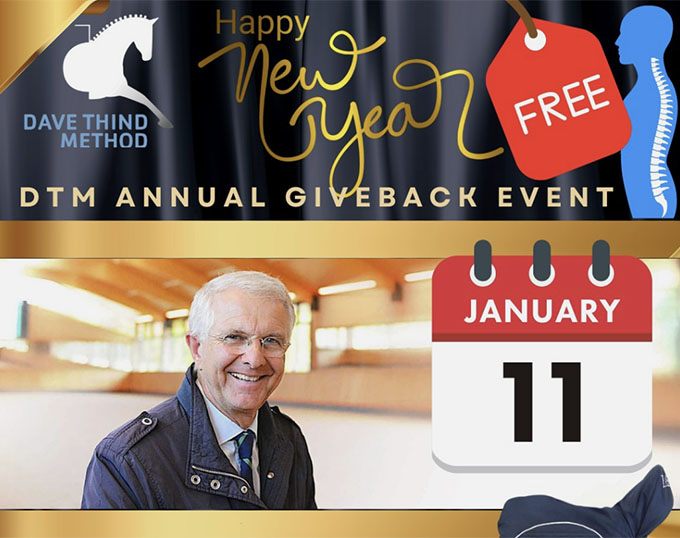
Dave Thind, a guild certified Feldenkrais® practitioner and German Trainer A, has kicked off his free, five-class series of "Feldenkrais for Riders" in December and in his second session he welcomed a celebrity guest rider, U.S. Grand Prix Champion Charlotte Jorst, for his educational, entry-level body awareness class on Zoom.
Horse lovers from all ages, body shapes, sizes, and activity levels as well as hobbyists and professionals participated in this 1h15 minute Zoom session in which Thind consistently stressed the importance of 'having fun', 'no judgment', 'no expectations.'
“Don’t obsess about being perfect and having to learn. A natural way of learning is based on experimenting, trial and error. This module is only a guideline to play with, said Dave who will be based in Wellington, Florida, this winter.
For the Love of Horses
At the start of the session, Thind clearly stated that, "we're trying to make our seat better and increase performance, but we do this also just because we love our horses. We want to help our horses by our way of riding and our improved mechanics. The one thing we can do from home is educate ourselves how we can move better."
Thind's seat instruction are really "body awareness" classes in which he teaches you to feel and balance your skeleton and muscles. With a soft and calm voice he invites you to micro-move small bones in your body and makes you aware of how stiff, supple, balanced, flexible or rigid you really are.
"We all know there is a stiff and hollow side with horses and every horse has difficulty bending to one side. Most riders prefer to ride the side in which their horse bends too much and end up getting a crooked horse. We also have a stiff and hollow side and we are wired to operate from that place," he explained.
"We have to gymnasticise the horse in a way that it feels it's not being corrected," Thind continued. "We have to make a horse equally available on both sides," and then Dave remarked that this is more or less the same for riders.
A Mental Body Scan
Thind briefly summarised the focal points of the previous zoom session and stressed the "four points:" the two shoulder and hip joints. Newcomers to his class that missed previous sessions can easily join in without feeling lost. Thind asked each participant to sit on a chair and do a quick body awareness scan, called an "approximation."
Each exercise was tackled from a rider perspective and so was this mental body scan.
"Imagine the weight distribution in your pelvis and in your stirrups," he told his participants who were asked to be seated on a chair. "How much of your weight is in your stirrup and how much in your pelvis? Is there one point you prefer to favour? Do you press more on one side? What about calf pressure? Is there one leg that presses much, pushing more? Is there one leg that is more passive and likes to hang? One thigh that likes to clamp more? Try to make yourself aware of how you sit. Is there a habit you are aware of. Are you weighting a seat bone more than another, collapsing in the hip?"
Thind invited his participants to mentally project how they believe they sit in the saddle.
"Feldenkrais is as much about the mind as the muscle," Dave stated. "If you realise you sit crooked, saddle fit for your horse will become an issue. In time it will need more reflocking on one sidle, or your horse develops issues. There is no judgment here, we all try to be better for the love of horses. So much can be built based on positivity and optimism."
Charlotte Jorst, Swimming Against the Current

Before the class started she mentioned that, "Feldenkrais has done wonders for me. It feels like it does nothing, but it's created an awareness of what I do, the muscles I use and the impact it has on a horse. It's amazing."
During the zoom session, Jorst spoked about how often she drops the stirrups to reassess her "four points" and checks if she is in balance in the saddle.
"I make sure I have everything centered," Charlotte explained. "You get yourself stiff, or your horse gets stiff and worries, so I do a lot of walking. I often even put my arms up above my head to re-center myself. You can help your horse relax by focusing on your own body awareness. By-pass a stressed horse by talking walk breaks, or walking, re-setting, coming back to zero, or dropping to zero."
Dave highlighted that by finding the four points we "reset our whole musculature and nervous system." Jorst continued with two examples of how her horses overcame stressful situations.
"Zhaplin is a horse that worries a lot, he wouldn't even go in the ring in the beginning, but now he goes in with his ears forward. It's huge thing," she exclaimed. "With Boticelli I sometimes just stand in a corner as he otherwise just wants to walk very fast. It’s not always about the break your horse needs, but also the break you need," she said.
Jorst was very outspoken about trying your own tactics and not always going for what a trainer recommends you to do.
"If your trainer says it works one way, don’t be afraid to try a different way that works for you," she said with a smile. "I was told you ride pirouettes in a square, first quarter pirouettes and then again and again, but I put the haunches in, head down and make the horse come up like a cat and relax first, so they don’t anticipate any danger coming into the pirouette for a couple of months. When the horse is ready then you can inch the head up a little bit. In the ring I can now sit back and he’ll put the head up himself. A great moment not to listen to the trainer."
"Early Aquatic Life Movement"
Then the practical part of the Zoom session followed in which participants moved onto the floor for some spinal cord and dorsal muscle exercises, which Thind referred to as the "early aquatic life movement."

A role play game followed in which Thind invited everyone to image they are a horse, swooshing the tail from left to right, as well as moving one and then the other hind leg under the body. This "playing horse" seemed odd at first, but it was the trigger for mental body awareness.
The real exercises followed, but this initial movement served as a reference, something to come back to see if suddenly something was easier. It was also a neat perspective on how our horses bend and move. Participants were lying on their back and practiced side-bending of the spine. Thind's slow and calm voice was simultaneously soothing and instructing.
"Try to move your tailbone slightly to the right and back to the middle, while still lying on your back," he said. Early in the class, Dave demonstrated some landmarks on a model skeleton. "Try to move L5 to the left without tipping your pelvis. Trying to micro-move L5 and L4. Do you do anything with your eyes? You might feel your jaw move slightly over," he said. "You will feel like you have a C-shape in your spine."
Refine Your Sensory Abilities
A set of exercises were carried out to supple the spine and lengthen the legs. The entire goal of the session was for participants to activate their brain and achieve micro-movement, or what Thind called "gourmet movements".
It was not a physical work-out as some might fear from such Zoom sessions, not hot yoga that makes one drip in sweat and feel more exhausted afterwards. Thind's body awareness classes are more about connecting the brain/the mental with the body/the physical. It's a self-exploration.
"Riders can refine their sensory abilities to listen to the horse," he added. "We are refining the awareness of one’s own body. Like fine tuning a musical instrument. We’re not obsessed by the end goal. It’s an exploration. For example, this tail swing lesson, does it make you more supple in your pelvis?"
At the end of the class he asked, "how does it feel to stand, walk around? how do you feel? We are not trying to be perfect here." The session finished with a question and comment round and Charlotte Jorst summarized it by stating, "I feel so rested and happy after these lessons," while Brandi, who is recovering from a car accident, added "this has been so transformational for me. I’m super excited."
Next Celebrity Guest: Christoph Hess

To receive the meeting link, please register at https://www.davethindmethod.com/offers/GzxnBdgt.. No purchase is necessary and all are welcome.
Over 850 people are now registered for this free series. If you did not yet register, you still can. Next class is lesson #3. Register for free and you get access to the live class as well as 24-hr long access to a free replay.